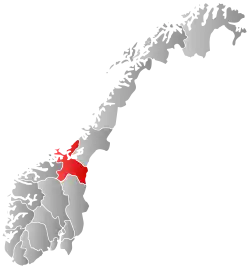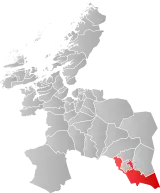Rural Municipality of Røros
Røros landsogn | |
|---|---|
 Sør-Trøndelag within Norway | |
 Røros landsogn within Sør-Trøndelag | |
| Coordinates: 62°30′30″N 11°32′49″E / 62.50833°N 11.54694°E | |
| Country | Norway |
| County | Sør-Trøndelag |
| District | Gauldalen |
| Established | 1926 |
| • Preceded by | Røros Municipality |
| Disestablished | 1 Jan 1964 |
| • Succeeded by | Røros Municipality |
| Administrative centre | Røros |
| Area (upon dissolution) | |
| • Total | 729 km2 (281 sq mi) |
| Demonym | Rørosing[1] |
| Official language | |
| • Norwegian form | Neutral |
| Time zone | UTC+01:00 (CET) |
| • Summer (DST) | UTC+02:00 (CEST) |
| ISO 3166 code | NO-1641[3] |
Røros landsogn (English: Røros rural parish) is a former municipality in the old Sør-Trøndelag county in Norway. The 729-square-kilometre (281 sq mi) municipality encompassed the southern part of the what is now the municipality of Røros in Trøndelag county. The municipality nearly surrounded the small enclave that was the mining town of Røros and it stretched all the way southeast to the lake Femunden and the Swedish border.[4] The administrative centre of the municipality was located in the town of Røros where Røros Church is located.
History
The rural part of the parish of Røros was established as the municipality of Røros landsogn in 1926 when the large municipality of Røros was split into four separate municipalities: Glåmos (population: 983), Brekken (population: 1,098), Røros landsogn (population: 701), and the town of Røros (population: 2,284). During the 1960s, there were many municipal mergers across Norway due to the work of the Schei Committee. On 1 January 1964, the four municipalities of Glåmos (population: 700), Brekken (population: 964), Røros landsogn (population: 482), and the town of Røros (population: 3,063) were all reunited under the name Røros.[5]
Name
The municipality is named after the town of Røros and the name landsogn means "rural district", hence it is the rural district surrounding the town of Røros. The town is named after the old Røros farm (Old Norse: Røyðaróss). The first element comes from the local river name Røa (Røyðr) which has an unknown meaning. The last element comes from os which means "mouth of a river" (the small river Røa runs into the great river Glåma here).[6]
Government
While it existed, this municipality was responsible for primary education (through 10th grade), outpatient health services, senior citizen services, unemployment, social services, zoning, economic development, and municipal roads. During its existence, this municipality was governed by a municipal council of elected representatives, which in turn elected a mayor.[7]
Mayors
Municipal council
The municipal council (Herredsstyre) of Røros landsogn was made up of 13 representatives that were elected to four year terms. The party breakdown of the final municipal council was as follows:
| Party name (in Norwegian) | Number of representatives | |
|---|---|---|
| Labour Party (Arbeiderpartiet) | 8 | |
| Local List(s) (Lokale lister) | 5 | |
| Total number of members: | 13 | |
| Party name (in Norwegian) | Number of representatives | |
|---|---|---|
| Labour Party (Arbeiderpartiet) | 7 | |
| Local List(s) (Lokale lister) | 6 | |
| Total number of members: | 13 | |
| Party name (in Norwegian) | Number of representatives | |
|---|---|---|
| Labour Party (Arbeiderpartiet) | 7 | |
| Local List(s) (Lokale lister) | 5 | |
| Total number of members: | 12 | |
| Party name (in Norwegian) | Number of representatives | |
|---|---|---|
| Labour Party (Arbeiderpartiet) | 7 | |
| Communist Party (Kommunistiske Parti) | 2 | |
| Farmers' Party (Bondepartiet) | 3 | |
| Total number of members: | 12 | |
| Party name (in Norwegian) | Number of representatives | |
|---|---|---|
| Labour Party (Arbeiderpartiet) | 6 | |
| Communist Party (Kommunistiske Parti) | 2 | |
| Local List(s) (Lokale lister) | 4 | |
| Total number of members: | 12 | |
| Party name (in Norwegian) | Number of representatives | |
|---|---|---|
| Labour Party (Arbeiderpartiet) | 7 | |
| Local List(s) (Lokale lister) | 5 | |
| Total number of members: | 12 | |
| Note: Due to the German occupation of Norway during World War II, no elections were held for new municipal councils until after the war ended in 1945. | ||
See also
References
- ↑ "Navn på steder og personer: Innbyggjarnamn" (in Norwegian). Språkrådet.
- ↑ "Forskrift om målvedtak i kommunar og fylkeskommunar" (in Norwegian). Lovdata.no.
- ↑ Bolstad, Erik; Thorsnæs, Geir, eds. (26 January 2023). "Kommunenummer". Store norske leksikon (in Norwegian). Kunnskapsforlaget.
- ↑ Haugen, Morten, ed. (18 July 2017). "Røros landsogn". Store norske leksikon (in Norwegian). Kunnskapsforlaget. Retrieved 1 January 2018.
- ↑ Jukvam, Dag (1999). "Historisk oversikt over endringer i kommune- og fylkesinndelingen" (PDF) (in Norwegian). Statistisk sentralbyrå. ISBN 9788253746845.
- ↑ Rygh, Oluf (1901). Norske gaardnavne: Søndre Trondhjems amt (in Norwegian) (14 ed.). Kristiania, Norge: W. C. Fabritius & sønners bogtrikkeri. p. 199.
- ↑ Hansen, Tore; Vabo, Signy Irene, eds. (20 September 2022). "kommunestyre". Store norske leksikon (in Norwegian). Kunnskapsforlaget. Retrieved 1 January 2023.
- ↑ Sundt, Johannes (1992). Røros før – og nå … Utgitt i anledning 150-årsjubileet til RørosBanken (in Norwegian). Røros. p. 169.
{{cite book}}: CS1 maint: location missing publisher (link) - ↑ "Kommunevalgene og Ordførervalgene 1959" (PDF) (in Norwegian). Oslo: Statistisk sentralbyrå. 1960. Retrieved 20 April 2020.
- ↑ "Kommunevalgene og Ordførervalgene 1955" (PDF) (in Norwegian). Oslo: Statistisk sentralbyrå. 1957. Retrieved 20 April 2020.
- ↑ "Kommunevalgene og Ordførervalgene 1951" (PDF) (in Norwegian). Oslo: Statistisk sentralbyrå. 1952. Retrieved 20 April 2020.
- ↑ "Kommunevalgene og Ordførervalgene 1947" (PDF) (in Norwegian). Oslo: Statistisk sentralbyrå. 1948. Retrieved 20 April 2020.
- ↑ "Kommunevalgene og Ordførervalgene 1945" (PDF) (in Norwegian). Oslo: Statistisk sentralbyrå. 1947. Retrieved 20 April 2020.
- ↑ "Kommunevalgene og Ordførervalgene 1937" (PDF) (in Norwegian). Oslo: Statistisk sentralbyrå. 1938. Retrieved 20 April 2020.
